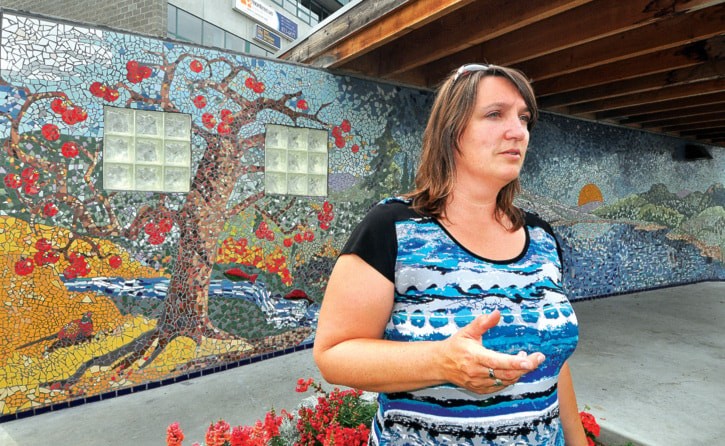A mosaic tile project at the Ross Street Stage is drawing rave reviews.
Five years in the making, the colourful scene captures the essence of the lush and productive Shuswap’s four seasons.
“After I noticed the cement wall was probably gonna stay like that, I started thinking a permanent graffiti-proof idea would be mosaics,” says creator and designer Tracey Kutschker, director/curator of the Salmon Arm Art Gallery.
Glen Andersen, a tile artist from the Coast, provided training workshops several years ago when the first tile projects got underway.
With the success of those colourful mosaics in Fletcher Park and the Ross Street fountain in mind, Kutschker began collaborating with Andersen two years ago.
“I knew it was going to cost money, but I wasn’t sure where I was going to get it, or who was going to get it,” she says of the $18,000 budget. “I didn’t just want to hire Glen because I knew there should be community involvement.”
Kutschker broached the Shuswap Arts Council board with her idea and says it was approved and relegated to her to “figure out.”
Artistic assistance came from Runaway Moon Theatre’s Cathy Stubington, whose Calendario project promotes using agricultural indicators rather than the monthly calendar to define the seasons in the Shuswap.
After collaborating with Stubington and Andersen, Kutschker began creating the overall design.
She figured out how many square feet of each colour of tile was needed, after which Andersen began months of purchasing tile from across North America and as far away as Italy.
A call to Salmon Arm Secondary art teacher Chris Schielke was met with enthusiastic approval and plans were made to involve his students in the project.
“I went forward knowing the kids would be involved, mostly in labour,” Kutschker says, noting the initial sketch was a basic design that included landforms, trees, spawning salmon, osprey, flowers and ducks, but left ample space for students to contribute their own creativity to the mosaic.
“The teachers walk-out made it really difficult for us to fully engage all the students, so that’s when we opened it up to the community,” she says of the project that was meant to be youth-oriented.
“There were probably 20 or 30 people who were keeners and put in serious hours,” says Kutschker, noting a Grade 3 class did help out one day before the strike took effect. “Another 50 or 60 came and did their part, and were happy with that.”
Andersen arrived in Salmon Arm in early June to teach another workshop and spent a second weeklong stint helping with the tiling.
“The project took seven weeks total instead of the initial two and I am so grateful to the community who came out to make it happen,” Kutschker says. “This was something very real that we could do that was creative, encompassing and exciting.”
Kutschker says the project was successful on many fronts, including introducing new people to the arts council.
As well as giving those who took part pleasure in knowing they have contributed to art that could be around more than 100 years from now, Kutschker says there is success, too, in the fact that people walk by the mosaic and smile their approval and enjoyment.
